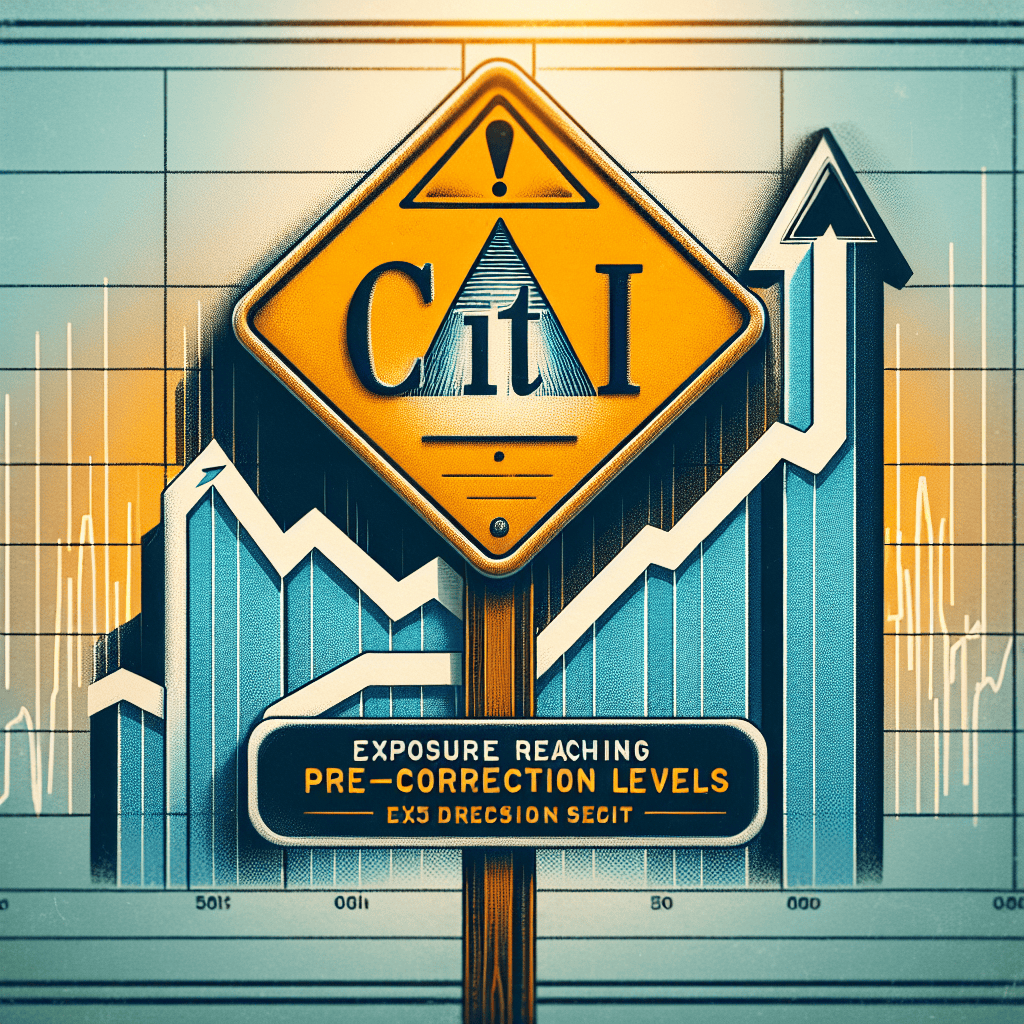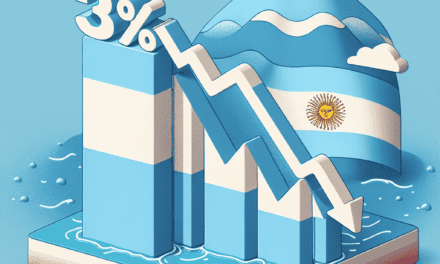“Brace for Impact: Citi Flags S&P 500’s Return to Pre-Correction Heights”
Introduction
Citigroup has issued a cautionary note regarding the S&P 500, highlighting that its exposure levels are approaching those seen prior to previous market corrections. This warning comes amid growing concerns about potential overvaluation in the stock market, as investors continue to drive up prices in a prolonged bull market. Citi’s analysis suggests that the current market dynamics bear similarities to past periods of heightened risk, prompting investors to reassess their portfolios and consider the implications of a possible market downturn. The bank’s alert underscores the importance of vigilance and strategic risk management in navigating the complexities of today’s financial landscape.
Understanding Citi’s Warning: S&P 500 Exposure Risks
Citi’s recent warning about the S&P 500 exposure reaching pre-correction levels has sparked considerable attention among investors and financial analysts. This cautionary note comes at a time when the market is experiencing a complex interplay of factors, including economic recovery, inflation concerns, and geopolitical tensions. Understanding the implications of Citi’s warning requires a closer examination of the current market dynamics and the potential risks associated with heightened exposure to the S&P 500.
To begin with, the S&P 500 index, which comprises 500 of the largest publicly traded companies in the United States, serves as a barometer for the overall health of the U.S. stock market. Historically, periods of high exposure to the S&P 500 have often preceded market corrections, where stock prices undergo a significant decline. Citi’s warning suggests that the current level of exposure is reminiscent of those seen before previous market corrections, raising concerns about the sustainability of the current market rally.
One of the primary factors contributing to the increased exposure is the robust performance of the technology sector, which has been a major driver of the S&P 500’s gains. Companies such as Apple, Microsoft, and Amazon have seen their stock prices soar, leading to a concentration of market capitalization within a few key players. This concentration poses a risk, as any negative developments affecting these companies could have a disproportionate impact on the index as a whole. Moreover, the reliance on a narrow group of stocks for market gains can lead to increased volatility, as investors may react swiftly to any changes in the outlook for these companies.
In addition to sector concentration, macroeconomic factors also play a crucial role in shaping the current market environment. The ongoing economic recovery from the COVID-19 pandemic has been accompanied by rising inflationary pressures, prompting concerns about potential interest rate hikes by the Federal Reserve. Higher interest rates could lead to increased borrowing costs for companies, potentially dampening corporate profits and, in turn, affecting stock prices. Furthermore, geopolitical tensions, such as trade disputes and international conflicts, add another layer of uncertainty to the market, potentially exacerbating the risks associated with high exposure to the S&P 500.
Given these considerations, investors are faced with the challenge of navigating a complex and potentially volatile market landscape. Diversification remains a key strategy for mitigating risk, as spreading investments across different asset classes and sectors can help cushion the impact of a market correction. Additionally, maintaining a long-term investment perspective can provide a buffer against short-term market fluctuations, allowing investors to ride out periods of volatility without making hasty decisions based on temporary market movements.
In conclusion, Citi’s warning about the S&P 500 exposure reaching pre-correction levels serves as a timely reminder for investors to reassess their portfolios and consider the potential risks associated with the current market environment. While the allure of strong market gains can be tempting, it is essential to remain vigilant and adopt a balanced approach to investing. By understanding the factors contributing to the current exposure levels and taking proactive steps to manage risk, investors can better position themselves to weather potential market corrections and achieve their long-term financial goals.
Historical Context: Pre-Correction Levels of the S&P 500
In the ever-evolving landscape of global finance, the S&P 500 serves as a critical barometer for the health and direction of the U.S. stock market. Recently, Citi has issued a cautionary note regarding the S&P 500’s exposure, suggesting that it is approaching levels reminiscent of those seen before previous market corrections. To fully appreciate the implications of this warning, it is essential to delve into the historical context of pre-correction levels of the S&P 500 and understand the potential risks and opportunities that lie ahead.
Historically, the S&P 500 has experienced several significant corrections, each marked by a period of rapid growth followed by a sharp decline. These corrections are often precipitated by a combination of factors, including overvaluation, economic downturns, and geopolitical tensions. For instance, the dot-com bubble of the late 1990s and early 2000s saw the S&P 500 reach unprecedented heights before a dramatic correction ensued. Similarly, the financial crisis of 2008 was preceded by a period of robust market performance, only to be followed by a severe downturn.
In examining the current situation, Citi’s warning highlights the potential for a similar pattern to emerge. The S&P 500 has been on an upward trajectory, driven by a combination of strong corporate earnings, low interest rates, and investor optimism. However, this growth has also led to concerns about overvaluation, as stock prices have surged to levels that some analysts believe may not be sustainable in the long term. This raises the question of whether the market is once again approaching a tipping point.
Moreover, the global economic environment adds another layer of complexity to the situation. While the U.S. economy has shown resilience, there are signs of potential headwinds on the horizon. Inflationary pressures, supply chain disruptions, and geopolitical uncertainties could all contribute to a shift in market sentiment. In this context, Citi’s warning serves as a reminder of the need for vigilance and careful consideration of the risks associated with current market conditions.
Transitioning from historical analysis to present-day implications, it is crucial for investors to assess their exposure to the S&P 500 and consider strategies to mitigate potential risks. Diversification remains a key principle in managing investment portfolios, as it can help cushion the impact of market volatility. Additionally, investors may want to explore alternative asset classes or sectors that could offer more stability in the event of a market correction.
Furthermore, it is important to recognize that while market corrections can be unsettling, they also present opportunities for astute investors. A correction can lead to more attractive valuations, providing a chance to acquire quality assets at a lower cost. Therefore, maintaining a long-term perspective and staying informed about market trends and economic indicators can be advantageous.
In conclusion, Citi’s warning about the S&P 500’s exposure reaching pre-correction levels serves as a timely reminder of the cyclical nature of financial markets. By understanding the historical context and potential risks, investors can make informed decisions to navigate the complexities of the current market environment. As always, a balanced approach that considers both risks and opportunities will be essential in achieving long-term financial goals.
Analyzing Market Trends: S&P 500’s Current Position
In recent months, the financial landscape has been marked by a series of fluctuations, with the S&P 500 index capturing significant attention from investors and analysts alike. Citi’s latest warning about the S&P 500’s exposure reaching pre-correction levels has sparked a renewed interest in understanding the underlying dynamics of the market. As we delve into the current position of the S&P 500, it is crucial to consider the factors contributing to this development and the potential implications for investors.
To begin with, the S&P 500, a benchmark index representing 500 of the largest publicly traded companies in the United States, serves as a barometer for the overall health of the stock market. Historically, the index has experienced periods of growth followed by corrections, which are typically defined as declines of 10% or more from recent highs. These corrections are often seen as necessary adjustments that help maintain market stability. However, Citi’s recent analysis suggests that the S&P 500 is once again approaching levels that preceded previous market corrections, raising concerns about the sustainability of its current trajectory.
One of the primary drivers behind the S&P 500’s recent performance is the robust recovery of the U.S. economy following the disruptions caused by the COVID-19 pandemic. As businesses reopened and consumer confidence rebounded, corporate earnings surged, propelling stock prices upward. Additionally, the Federal Reserve’s accommodative monetary policies, including low interest rates and quantitative easing measures, have provided further support to the equity markets. These factors have collectively contributed to the S&P 500’s impressive gains, yet they also underscore the potential for volatility as the market adjusts to changing economic conditions.
Moreover, the composition of the S&P 500 has evolved over time, with technology companies playing an increasingly dominant role. The rapid growth of tech giants such as Apple, Microsoft, and Amazon has significantly influenced the index’s performance, leading to concerns about concentration risk. As these companies continue to drive the market, any adverse developments in the tech sector could have outsized effects on the S&P 500, amplifying the potential for a correction.
In light of these considerations, investors are faced with the challenge of navigating an environment characterized by both opportunities and risks. On one hand, the ongoing economic recovery and strong corporate earnings present a favorable backdrop for equities. On the other hand, the prospect of rising interest rates, inflationary pressures, and geopolitical uncertainties could pose headwinds for the market. Consequently, investors must remain vigilant and adopt a balanced approach to portfolio management, taking into account both the potential for further gains and the need for risk mitigation.
Furthermore, it is essential to recognize that market corrections, while often unsettling, are a natural part of the investment cycle. They provide opportunities for investors to reassess their strategies, identify undervalued assets, and position themselves for long-term growth. As Citi’s warning highlights the S&P 500’s exposure to pre-correction levels, it serves as a timely reminder for investors to exercise caution and maintain a diversified portfolio.
In conclusion, the current position of the S&P 500 reflects a complex interplay of economic, monetary, and sector-specific factors. While the index’s recent performance has been impressive, Citi’s warning underscores the importance of remaining vigilant in the face of potential market corrections. By understanding the underlying trends and adopting a prudent investment approach, investors can navigate the evolving landscape and capitalize on opportunities while managing risks effectively.
Investor Strategies: Navigating Potential S&P 500 Corrections

In recent months, Citi has issued a cautionary note to investors, highlighting that the exposure of the S&P 500 is approaching levels reminiscent of those seen before previous market corrections. This development has prompted a renewed focus on investor strategies, as market participants seek to navigate the potential volatility that may arise. Understanding the implications of this exposure is crucial for investors aiming to safeguard their portfolios while capitalizing on potential opportunities.
The S&P 500, a benchmark index representing the performance of 500 of the largest publicly traded companies in the United States, serves as a barometer for the overall health of the stock market. Historically, when the index reaches elevated levels of exposure, it often signals heightened risk, as valuations may become stretched and susceptible to external shocks. Citi’s warning underscores the importance of vigilance and strategic planning in such an environment.
One of the primary concerns associated with high exposure levels is the potential for a market correction. Corrections, defined as a decline of at least 10% from recent highs, are a natural part of market cycles. They can be triggered by a variety of factors, including economic data releases, geopolitical tensions, or shifts in monetary policy. As the S&P 500 approaches pre-correction levels, investors must be prepared for the possibility of increased volatility and the subsequent impact on their portfolios.
To navigate these uncertain waters, diversification remains a cornerstone of effective investment strategy. By spreading investments across different asset classes, sectors, and geographic regions, investors can mitigate the risks associated with a concentrated exposure to the S&P 500. This approach not only helps in cushioning the impact of a potential correction but also provides opportunities for growth in areas that may outperform during periods of market stress.
Moreover, investors should consider the role of defensive sectors in their portfolios. Sectors such as utilities, consumer staples, and healthcare have historically demonstrated resilience during market downturns. These sectors tend to offer stable cash flows and are less sensitive to economic cycles, making them attractive options for those seeking to reduce risk while maintaining exposure to equities.
In addition to diversification and sector allocation, investors may also explore alternative investment strategies. Hedging techniques, such as options and futures, can provide a layer of protection against downside risk. While these instruments require a certain level of expertise, they can be effective tools for managing volatility and preserving capital during turbulent times.
Furthermore, maintaining a long-term perspective is essential when navigating potential corrections. Market fluctuations are inevitable, and short-term volatility should not deter investors from their overarching financial goals. By focusing on the fundamentals of the companies within the S&P 500 and adhering to a disciplined investment approach, investors can weather the storm and potentially emerge stronger on the other side.
In conclusion, Citi’s warning about the S&P 500’s exposure reaching pre-correction levels serves as a timely reminder for investors to reassess their strategies. By embracing diversification, considering defensive sectors, exploring alternative strategies, and maintaining a long-term perspective, investors can better position themselves to navigate potential corrections. As the market landscape continues to evolve, staying informed and adaptable will be key to achieving investment success in the face of uncertainty.
Economic Indicators: What Signals a Market Correction?
In recent financial analyses, Citi has raised concerns about the S&P 500’s exposure levels, suggesting they are approaching those seen before previous market corrections. This observation has sparked discussions among investors and analysts about the potential implications for the broader economy. Understanding the signals that precede a market correction is crucial for stakeholders aiming to navigate the complexities of financial markets effectively.
Historically, market corrections, defined as a decline of 10% or more in stock prices from their most recent peak, have been preceded by certain economic indicators. One such indicator is the valuation of stocks relative to their earnings, commonly measured by the price-to-earnings (P/E) ratio. When this ratio reaches unusually high levels, it often signals that stocks are overvalued, increasing the likelihood of a correction. Currently, the S&P 500’s P/E ratio is nearing levels that have historically preceded corrections, raising red flags for market participants.
Moreover, interest rates play a pivotal role in influencing market dynamics. As central banks adjust interest rates to manage economic growth and inflation, these changes can significantly impact stock valuations. For instance, rising interest rates typically lead to higher borrowing costs, which can dampen corporate profits and, consequently, stock prices. With the Federal Reserve hinting at potential rate hikes to combat inflationary pressures, investors are closely monitoring how these adjustments might affect the S&P 500’s trajectory.
In addition to valuation metrics and interest rates, investor sentiment is another critical factor that can signal an impending market correction. When optimism in the market reaches excessive levels, it often leads to speculative behavior, driving stock prices beyond their intrinsic values. This exuberance can create a bubble that, when burst, results in a sharp market correction. Recent surveys and sentiment indices suggest that investor confidence is high, which, while positive in some respects, also warrants caution given the historical context.
Furthermore, geopolitical events and macroeconomic trends can also serve as harbingers of market corrections. Trade tensions, political instability, and global economic slowdowns can introduce uncertainty into financial markets, prompting investors to reassess their risk exposure. The current global landscape, marked by ongoing trade negotiations and geopolitical tensions, adds another layer of complexity to the market outlook. These factors, combined with domestic economic indicators, create a multifaceted environment that investors must navigate with care.
While Citi’s warning about the S&P 500’s exposure levels is a cause for vigilance, it is essential to recognize that market corrections, though unsettling, are a natural part of market cycles. They serve to recalibrate valuations and can present opportunities for astute investors to acquire assets at more reasonable prices. However, the challenge lies in accurately predicting the timing and magnitude of such corrections, which remains an elusive endeavor even for seasoned analysts.
In conclusion, as the S&P 500 approaches exposure levels reminiscent of pre-correction periods, it is imperative for investors to remain informed and vigilant. By closely monitoring economic indicators such as valuation metrics, interest rates, investor sentiment, and geopolitical developments, stakeholders can better position themselves to respond to potential market shifts. While the prospect of a correction may induce anxiety, it also underscores the importance of a well-considered investment strategy that balances risk and opportunity in an ever-evolving financial landscape.
Risk Management: Protecting Portfolios Amid S&P 500 Volatility
In the ever-evolving landscape of financial markets, risk management remains a cornerstone for investors seeking to protect their portfolios from volatility. Recently, Citi has issued a warning that the exposure of the S&P 500 is reaching levels reminiscent of those seen before previous market corrections. This development has prompted a renewed focus on the strategies investors can employ to safeguard their investments amid potential market turbulence.
The S&P 500, a benchmark index that tracks the performance of 500 of the largest companies listed on stock exchanges in the United States, is often viewed as a barometer of the overall health of the U.S. equity market. Historically, periods of heightened exposure to this index have been followed by significant market corrections, underscoring the importance of vigilance in risk management practices. As the index approaches these pre-correction levels, investors are urged to reassess their portfolio strategies to mitigate potential risks.
One of the primary concerns associated with high exposure to the S&P 500 is the concentration risk that arises from a heavy reliance on a limited number of large-cap stocks. In recent years, the index has been increasingly dominated by a handful of technology giants, whose performance can disproportionately influence the overall index. This concentration can lead to increased volatility, as any adverse developments affecting these companies could have a cascading effect on the broader market. Consequently, diversifying investments across different sectors and asset classes becomes a crucial strategy for managing risk.
Moreover, the current economic environment adds another layer of complexity to the risk management equation. With ongoing geopolitical tensions, fluctuating interest rates, and concerns about inflation, the market is rife with uncertainties that could trigger sudden shifts in investor sentiment. In such a climate, maintaining a balanced portfolio that includes a mix of equities, fixed income, and alternative investments can provide a buffer against potential downturns. By spreading risk across various asset classes, investors can reduce their vulnerability to market volatility.
In addition to diversification, employing hedging strategies can further enhance portfolio protection. Options and futures contracts, for instance, offer investors the ability to hedge against potential losses by locking in prices or setting predetermined levels for buying or selling assets. These financial instruments can serve as valuable tools for mitigating risk, particularly in volatile markets. However, it is essential for investors to thoroughly understand the mechanics and costs associated with these strategies to ensure they align with their overall investment objectives.
Furthermore, maintaining a long-term perspective is vital in navigating periods of market volatility. While short-term fluctuations can be unsettling, history has shown that markets tend to recover over time. By focusing on long-term goals and avoiding impulsive decisions driven by market noise, investors can better withstand the ups and downs of the market cycle. Regularly reviewing and adjusting investment strategies in response to changing market conditions can also help in maintaining alignment with risk tolerance and financial objectives.
In conclusion, as Citi’s warning highlights the potential risks associated with the current levels of S&P 500 exposure, investors are reminded of the importance of robust risk management practices. By diversifying portfolios, employing hedging strategies, and maintaining a long-term perspective, investors can better protect their investments amid the inherent volatility of financial markets. As the landscape continues to evolve, staying informed and proactive in risk management efforts will be key to navigating the challenges and opportunities that lie ahead.
Expert Opinions: Reactions to Citi’s S&P 500 Exposure Warning
Citi’s recent warning regarding the S&P 500’s exposure reaching pre-correction levels has sparked a flurry of reactions among financial experts and market analysts. This development has prompted a closer examination of the current market dynamics and the potential implications for investors. As the S&P 500 continues to climb, concerns about overvaluation and the possibility of a market correction have become increasingly pertinent. Citi’s cautionary note serves as a reminder of the cyclical nature of financial markets and the importance of vigilance in investment strategies.
To begin with, it is essential to understand the context in which Citi’s warning has emerged. The S&P 500, a benchmark index that tracks the performance of 500 of the largest publicly traded companies in the United States, has experienced a remarkable recovery since the pandemic-induced downturn in early 2020. This recovery has been fueled by a combination of factors, including unprecedented fiscal and monetary stimulus, robust corporate earnings, and a resurgence in consumer spending. However, as the index approaches levels reminiscent of those seen before previous market corrections, questions about sustainability and risk management have come to the forefront.
In light of Citi’s warning, financial experts have offered a range of perspectives on the potential risks and opportunities facing investors. Some analysts argue that the current market environment is characterized by excessive optimism, with valuations stretched beyond historical norms. They point to metrics such as the price-to-earnings ratio, which suggests that stocks may be overvalued relative to their earnings potential. This, they contend, could leave the market vulnerable to a correction, particularly if economic conditions or corporate earnings fail to meet expectations.
Conversely, other experts maintain a more optimistic outlook, emphasizing the resilience of the U.S. economy and the strength of corporate balance sheets. They argue that while valuations may appear elevated, they are justified by the robust earnings growth and the low-interest-rate environment that has persisted in recent years. Furthermore, they highlight the potential for continued innovation and productivity gains to drive future growth, thereby supporting current market levels.
Transitioning to the implications for investors, Citi’s warning underscores the importance of diversification and risk management in portfolio construction. Investors are advised to carefully assess their exposure to equities, particularly in sectors that have experienced significant appreciation. By diversifying across asset classes and geographies, investors can mitigate the impact of potential market volatility and enhance the resilience of their portfolios.
Moreover, Citi’s cautionary note serves as a timely reminder for investors to remain vigilant and adaptable in their investment strategies. As market conditions evolve, it is crucial to stay informed about macroeconomic trends, corporate earnings reports, and geopolitical developments that could influence market sentiment. By maintaining a disciplined approach and being prepared to adjust their strategies as needed, investors can navigate the complexities of the current market environment.
In conclusion, Citi’s warning about the S&P 500’s exposure reaching pre-correction levels has elicited a range of expert opinions, reflecting the diverse perspectives on the current state of the market. While some caution against potential overvaluation, others highlight the underlying strength of the economy and corporate earnings. Regardless of one’s outlook, the emphasis on diversification, risk management, and adaptability remains paramount for investors seeking to navigate the challenges and opportunities presented by today’s financial markets.
Q&A
1. **What is the main concern raised by Citi regarding the S&P 500?**
Citi has raised concerns that the S&P 500’s exposure levels are reaching those seen before previous market corrections, suggesting potential vulnerability to a downturn.
2. **What does “pre-correction levels” mean in this context?**
“Pre-correction levels” refer to the market conditions or valuation metrics that were present before a significant market correction or downturn occurred in the past.
3. **Why is reaching pre-correction levels significant for investors?**
Reaching pre-correction levels is significant because it may indicate that the market is overvalued or overheated, increasing the risk of a potential correction or decline in stock prices.
4. **What specific metrics or indicators is Citi likely monitoring?**
Citi is likely monitoring metrics such as price-to-earnings ratios, market volatility, investor sentiment, and other valuation indicators that can signal overvaluation or market risk.
5. **How might investors respond to Citi’s warning about the S&P 500?**
Investors might respond by reassessing their portfolios, considering risk management strategies, or potentially reducing exposure to equities to mitigate potential losses.
6. **What historical events might Citi be referencing with “pre-correction levels”?**
Citi might be referencing historical events such as the dot-com bubble burst in 2000, the financial crisis in 2008, or other significant market corrections where similar conditions were observed.
7. **What actions could Citi recommend to mitigate risks associated with high exposure levels?**
Citi could recommend diversifying portfolios, increasing allocations to less volatile asset classes, using hedging strategies, or maintaining a cautious approach to new investments.
Conclusion
Citi’s warning about the S&P 500’s exposure reaching pre-correction levels suggests that the market may be approaching a point of heightened risk, similar to conditions seen before previous market downturns. This could indicate that valuations are becoming stretched, investor sentiment is overly optimistic, or that external economic factors are not being fully priced in. As a result, there may be an increased likelihood of a market correction, prompting investors to exercise caution and consider re-evaluating their portfolios to mitigate potential risks.





